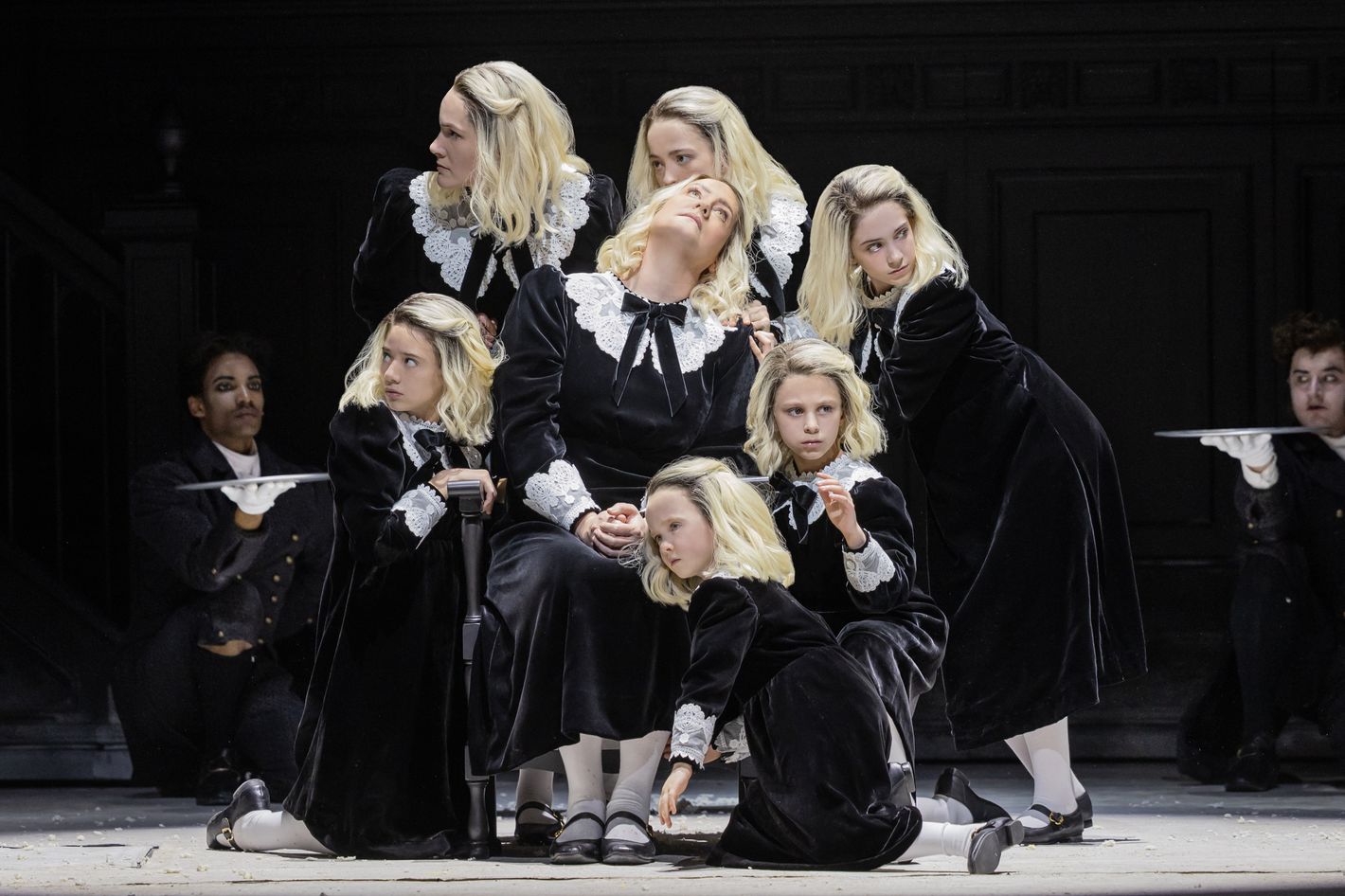

At the end of the Metropolitan Opera’s new production of Richard Strauss’s Salome, the soprano Elza van den Heever stayed onstage to accept the uproarious ovations with a weepy smile and a grateful tap on her heart. That moment of curtain-call niceness came as a shock on opening night, because for the previous two hours she had exuded the kind of casual, carnal evil that zombies would kill for.
What powers van den Heever’s performance is the gulf between the nastiness onstage and the glimmering warmth of her voice. While she is stabbing, whirling, demanding, and indulging in a blood-soaked smooch, she sings as if she were wandering primly through a sunny meadow. Strauss chiseled that fissure into her role, writing seductive music for a violent story. She’s not Elektra, hollering about cataclysm and spewing curses. She’s a twisted, spoiled girl, cajoling her smitten stepfather, Herod, into lopping off that sexy prisoner’s skull.
Director Claus Guth originally created this production to be shared between the Met and the Bolshoi Theatre in Moscow, a collaboration that broke down when Russia invaded Ukraine. (The Met has made its allegiances clear, hanging the blue-and-yellow flag, opening some performances with the Ukrainian national anthem, and hosting fundraising events.) And so the company re-created the staging, rebuilding Etienne Pluss’s sets, remaking Ursula Kudrna’s costumes, and casting the lifelike head of Jochanaan (a.k.a. St. John the Baptist) in the image of baritone Peter Mattei.
From the opening seconds, the director goes full Kubrick, ratcheting up the creepiness until the gross-out climax comes as a relief. In a less convincing performance, Guth’s goth staging might quickly start to look hokey. The palace’s black walls, a dungeon with rattling chains, a man in tuxedo and ram’s head groping a naked woman, Young Salome in her Wednesday Addams outfit — the whole gestalt teeters on the verge of black comedy and kitsch. To avoid tumbling over the edge, the director leans on grimness. Oscar Wilde’s play (which Strauss adapted for his libretto) compresses the action too much to allow for any real character development — the titular sociopath is just as sick at the beginning as she is at the end — so Guth fleshes it out with backstory. As the curtain opens, we expect the first sounds to be Strauss’s slithering clarinet solo rising through C-sharp minor. Instead, we get the plink of a music box. I’m surprised the Met’s music director, Yannick Nézet-Séguin, allowed that interpolation — embroidering the score of an opera is generally a no-no — but it’s effective as the accompaniment to a Victorian childhood. A little girl smashes her doll on the floor, just as the adolescent version will later knock over a statue that pulverizes when it hits the stage. We get glimpses of moral decay in flashbacks: the girl sitting immobile on a high shelf, clutching the doomed doll and watching her future incarnation romance the prisoner; the older Salome instructing her younger self how to slice the air with a toy sword and a sense of lethal purpose.
The opera became and has remained famous for its “Dance of the Seven Veils,” in which Strauss deliciously scored a disturbing act: a teenager’s public striptease. Guth keeps van den Heever clothed and instead turns it into a dance of the seven Salomes, all her previous selves and alter egos gathering around her in a physical display of the fractured mind.
But the true double-chambered heart of perversion is the pair of sexually charged encounters between Salome and Jochanaan, who is outraged in one scene and dead in the other. You can understand his appeal in the first instance: Mattei sings the role with virile power and a pious intensity that spills over into the erotic. But the real attraction for the crazed princess is that he can’t escape. He can only reject her come-on, which in her world is a capital offense. Later, when Salome descends into the palace’s bowels (or rather the dungeon rises to meet her), she finds Jochanaan in the divided form of a headless corpse, a corpseless head, and the memory of his magnetism. Van den Heever outdoes herself here: Not every great singer can get away with playing a scene of sloppy necrophilia with such aplomb. Fewer still can do that while singing with such untroubled suppleness, without a trace of steeliness or gristle in her voice.
In Guth’s reading, the opera is the culmination of a traumatic childhood, warped by terrible parenting. We can see — and hear — Mom and Dad’s faults for ourselves. Michelle DeYoung presides as the haughty mother, her blood-orange dress a streak of color on the monochrome stage. Gerhard Siegel earns the audience’s gratitude by singing Herod not as a weak-willed despot but as a comically lascivious burgher out of Rosenkavalier. They don’t seem so bad — certainly not bad enough to have formed such an unhinged daughter, only ill-equipped to cope with the person she’s become. And so it falls to the orchestra to fill in the psychic landscape. Under Nézet-Séguin, the musicians do the job spectacularly, releasing all those bilious harmonies and seething rhythms in an unbroken two-hour spasm of excitement.
Salome is at the Metropolitan Opera through May 24.

Latest News
For Sale! 2016 Sea Ray 350 Sundancer – $180,000
Reel Deal Yacht is pleased to feature a meticulously maintained 2016 Sea...
NFL fines Falcons and defensive coordinator Jeff Ulbrich following prank call to Shedeur Sanders
The Atlanta Falcons have been fined $250,000 and defensive coordinator Jeff Ulbrich...
Barcelona and Inter Milan draw 3-3 in thrilling first leg of their Champions League semifinal
Lamine Yamal’s curler that went in off the post after the teenager’s...
Atlanta’s Dyson Daniels wins the NBA’s most improved player award
Dyson Daniels’ emphasis on defense earned him a starting job in his...
Phoenix Mercury are heading into new era without Diana Taurasi and Brittney Griner
The Phoenix Mercury will open their first season in 21 years without...














Leave a comment